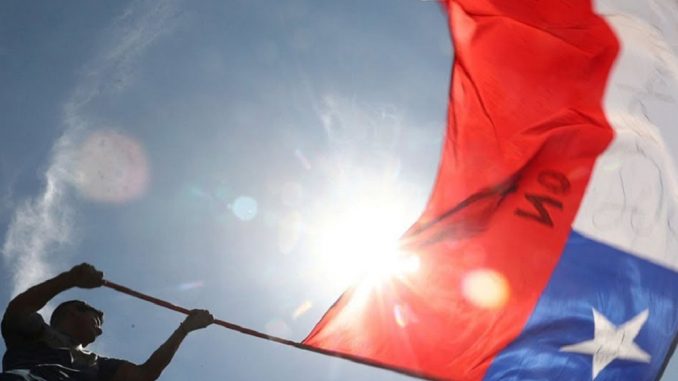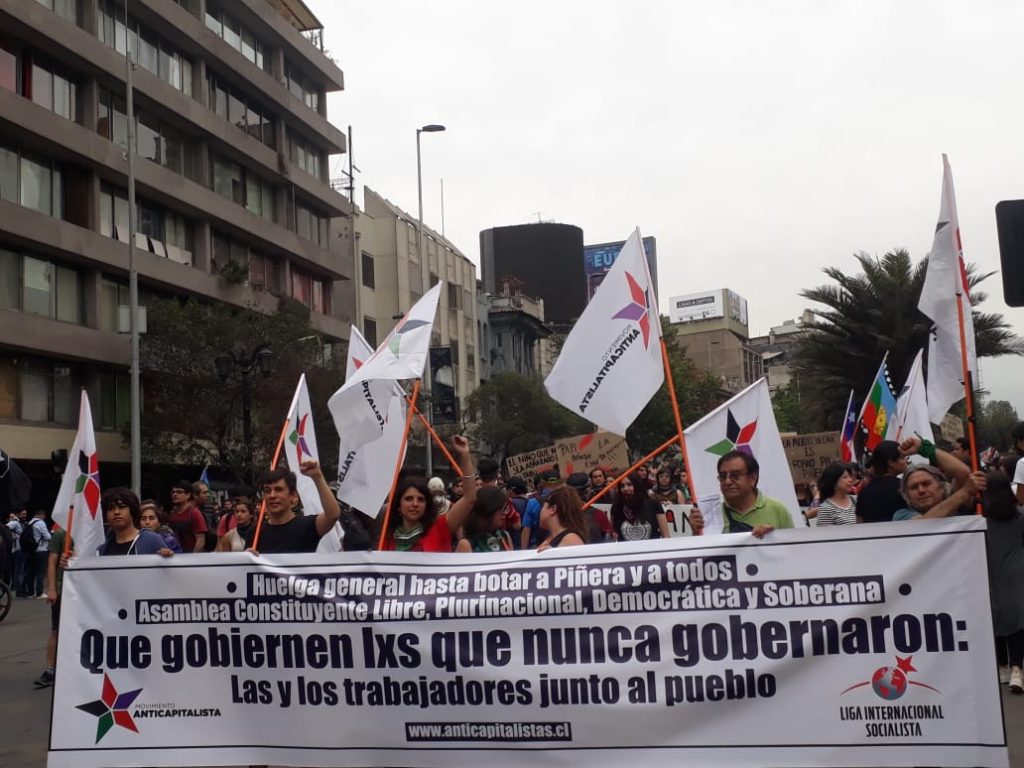
Chile thrills
and stirs us. The ongoing social and political process is a Latin American and
world peoples´ vendetta. We always believed in the accumulated reserves of the
Chilean people, of their youth, of their working class. We always vindicated the
1970-73 revolution and fought against the criminal ideology of “the
peaceful way” to socialism. We hate Pinochetism over all dictatorships.
That is why this vendetta is internationalist. A new political stage in the
country. Uncertain ending, exciting dynamics.
There is a French May mood. Like all
semi-spontaneous revolt action, the masses dominate the public space and
multiply messages, creativity, power. It would take a whole book just to record
the graffiti. «Chile woke up»; «Injustice trembles when you fight against those
who have nothing to lose»; “Pacos (cops) are assassins”; “If
revolution is necessary, revolution is possible.” And the most repeated: «Piñera
must go» and «New Constitution». Since Chile changed on October 18, it is
something else entirely.
Chile is in a state of almost economic paralysis.
The streets display a geography of intense class struggle: there are traces of
fires, of barricades, of popular rage that is repeated three times a day, every
day since almost a month ago. From the morning, marches, rallies, blocked
streets. In the afternoon, always a mobilization to Plaza Italia and La Alameda
round trip to La Moneda in Santiago. And as a daily postcard, as presumed,
repression with gases, water cannons and rubber bullets. The withdrawal to the
periphery is received by cacerolazos (protests with banging pots and pans) and
late into the night, pickets and barricades. Confrontations with the
“pacos”: the carabineros (military police). And so on, tirelessly.
And so on, throughout the country, from Arica to Punta Arenas. If you walk
downtown Santiago, the buildings speak: posters written by hand with
resolutions of councils, assemblies, meetings. Traffic lights do not work.
Public transportation, barely. The main supermarket chains and the emblems of
capitalist privileged consumerism, looted, burned. The revenge of the masses.
Thirty years unleashed. It moves you, it thrills you.

The regime, surpassed
Capitalism in Chile is mounted on a hard defeat. The genocidal violence that the bourgeoisie and imperialism used with Pinochet was proportional to the political volume of the opposing force it faced: the industrial “cordones” as an embryonic form of workers power; the boards of supply as a mechanism of social control against the market, speculation and lockouts. The role of Allende´s Socialist Party (PS) in tandem with the PC (Communist Party) betting on the conciliation of classes and the parliamentary route to socialism, and the MIR (Revolutionary Left Movement) with isolated actions and at the same time alternating the real cordones of the working class, “communal commands” invented by that ultra-left apparatus. There was plenty of strength, but the working class lacked a revolutionary leadership. To dismantle this revolution scaffolding, fascism showed all its class brutality. The exit of the dictatorship in 1989, agreed with the PS, Christian Democracy and the PC, laid the foundations of the political regime that is cornered today, which includes an antidemocratic “constitutional court” above the Parliament. It was based on guaranteeing impunity for the genocides and the basic pillars of brutal capitalism: privatization of social security; mercantilization of education and health care; job insecurity; union disarticulation and a limited bourgeois democracy, under the repressive guardianship of a police-military apparatus and of sinister espionage. The alternation between the Concertación (PS-DC), with the support of the PC and the right-wing of Pinochet heritage, managed bourgeois power in Chile with basic consensus until now. The accumulation of contradictions had milestones until reaching the current outbreak: in 2006 and 2011, with the youth as a protagonist against the education business; in 2018, the No + AFP movement against private social security. This year, the huge strike of the women’s movement. Before, the protests of the Mapuche people against the militarization of their territory, dispossession and crimes. There were other struggles, but the turning points were marked by young people, women, workers and the Mapuche people. Now, all the authoritarian arrogance of that regime is totally and completely overwhelmed by the objective confluence of all these demands in a single program that is synthesized in the slogan that the movement raises in the streets: “New Constitution.”
Not institutionalized dual power
A highlight of the process in Chile is that there are no emerging figures that are emblematic. Fights like those of 2011-2012 catapulted leaders like Camila Vallejo (now a deputy of the PC) or her “renovating” relays like Gabriel Boric or Giorgio Jackson, now deputies and leaders of the Broad Front (FA). The current revolt does not make any leaders visible. It is popular, though with an organized intervention of the working class in two strong general strikes – the latest one is being developed as we write this article – with a national character and an active component of the urban middle class and the inhabitants of the poor areas. The leadership is the independent action of the mass movement that shakes everything. At the same time, like any revolutionary phenomenon that begins, as it lasts in time without end, it generates phenomena of self-organization, that is incipient, embryonic, but set trends:
Neighborhood assemblies throughout the country, dozens of them across Santiago
* Cabildos: as an organizational form promoted from above by the PC and the FA they, however, end up overpowered and, instead of being fragmented “thematic debate commissions,” they result in popular assemblies. As in the assemblies, the youth component predominates.
* Territorial strike committees: still incipient, but that evidently reflect cracks in the union bureaucracy of the CUT -hegemonized by the PC- and develops the action of powerful organizations like the Port Union, which led those organisms that prepared the November 12 strike in the regions and communes. They are in tension with the National Strike Committee, controlled from above by the PC and the CUT.
* Coordination of assemblies and councils: we had the opportunity to participate, by bringing our internationalist greeting and accompanying our Chilean Movimiento Anticapitalista comrades, in the Coordination of Puente Alto, south of Santiago. That body brought together representatives of assemblies and cabildos in the area. There is also a Metropolitan Assembly of Assemblies, near the Olympic Village, also with dozens of base instances represented.
All these expressions are embryonic, not consolidated and have an erratic perspective, due to the orientation of the forces that act (see “Chile: polemics and forces in dispute”). But, on the whole, there is a true “dual power” on the streets that is not institutionalized. It is an enormous deliberative experience, of politicization and trial and error of the different politics the leaderships that thousands and thousands of young people, workers and sectors of the people are experiencing in the Chilean revolution.
Anti-capitalism, socialism and consciousness
The semi-insurrectional protest in Chile is driven by a set of demands, of causes that were expressed partially and that are now unified in a single mass movement. That is: objectively, the revolution has a program. Its banners are:
* Against the AFP (private social security), solidarity based social security system.
* No more job insecurity, wages according to the real basket.
* Free and universal public education and debt forgiveness.
* Legal, safe and free abortion. Declaration of emergency in gender violence. Integral Sex Education. Against all forms of labor inequality due to gender.
* Against the looting and depredation of mega-mining, and logging.
* Trial and
punishment of the genocides of the dictatorship and the crimes of the last 30
years.
* Repudiation
of the political system of privileges and justice of the regime.
These are the demands most felt by the movement as
a whole, those that arise in any elementary dialogue in the street. The answers
to these demands have a common character: they question the pillars of Chilean
capitalism and the regime of bourgeois democracy supervised by the heirs of
Pinochetism. They involve nationalizing the financial system to ensure a
solidarity based social security system; they imply labor laws against
precarization that question employer exploitation; they involve confronting the
clerical lobby and eliminating all subsidies to the churches; they involve
dismantling the repression and espionage apparatus; they propose to build an
independent investigative commission for the crimes of the dictatorship. That
is to say: it is objectively a revolutionary anti-capitalist movement – because
of the demands it poses – but it does not have a majority political leadership
that lifts that program and a method of general strike and revolutionary
self-organization to conquer it through a workers’ and popular government. That
is why we define it as “unconsciously socialist” and the task, then,
is to give it a conscious perspective. This means building a political
organization that has a program and perspectives in line with the mobilizing
causes of the masses. That is the challenge that is posed. That is the huge
contradiction of the Chilean revolution.
Mariano Rosa, Special Envoy to Santiago de Chile
The ISL, the Movimiento Anticapitalista of Chile and the MST
Capital is worldwide, international. So is its logic of exploitation and dispossession. This simple statement is the basis of our militancy and internationalist construction, to oppose corporations and their governments with our workers’, youth and popular resistance, with a revolutionary program and organization. The Internationalist Socialist League is built with the concrete intervention of its parties and groups in the real class struggle processes. It carries out militant support campaigns to promote active solidarity, at the front lines of each country, with the struggles and revolutions of the peoples of the world, and contribute to forming cadre parties for the socialist revolution. Chile today, is at the center of our international activity and at the same time, it has its young national organization, the Movimiento Anticapitalista, acting, growing and fusing in an exciting process, decisive for the revolution in Latin America. Fighting in assemblies, councils, marches and barricades for all the ideas we raise in each country and around the world: to defeat bourgeois governments with the general strike, promote free and sovereign constitutional processes that reorganize countries on socialist and truly democratic bases, preparing governments of those that have never governd: the workers and the people.
The ISL is deploying a solidarity campaign for Chile in its different national sections. At the same time, it has been supporting the activity of the Movimiento Anticapitalista with the MST of Argentina for weeks. Days ago, one of the MST´s main national figures, Cele Fierro, participated in women’s assemblies, mobilizations, talks in universities and meetings with the militants and activists of the Movimiento Anticapitalista. In turn, Mariano Rosa of the national leadership of the MST, working with the coordination of the ISL, collaborates in tasks of propaganda and organization in Chile, bringing the internationalist greeting of the Argentine party to assemblies and councils. In short: militant, active, practical internationalism of intervention in the class struggle to build national parties as part of an international revolutionary organization.
M.R.








